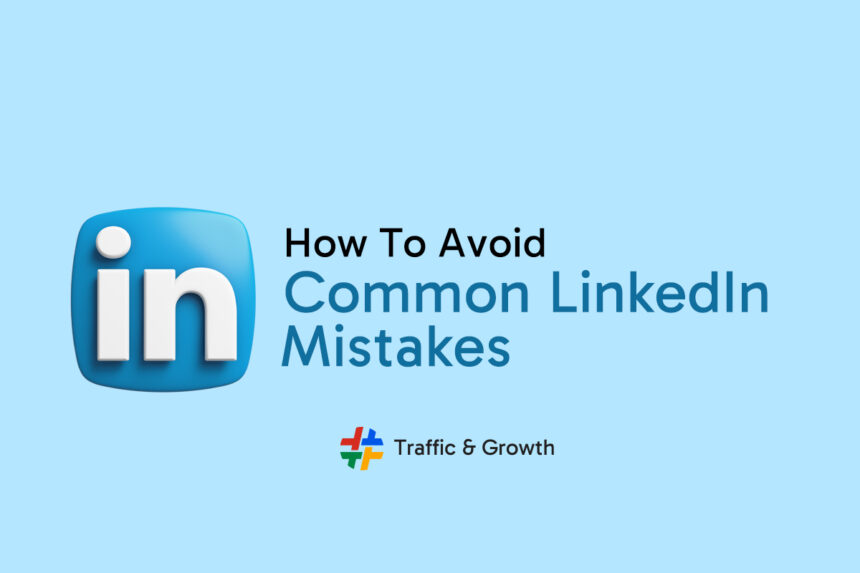LinkedIn is a powerful tool for professionals to showcase their skills and connect with potential employers or clients. However, many individuals make common mistakes on their LinkedIn profiles that can hinder their success. From profile picture blunders to neglecting the headline, there are several pitfalls to avoid when using LinkedIn.
One of the most common mistakes people make on LinkedIn is having an incomplete profile. Your profile is your online resume and personal brand, so it’s essential to ensure that it showcases your skills, achievements, and experiences. Neglecting to fill out important sections such as work experience or education can make you appear unprofessional and unprepared.
Another mistake to avoid is neglecting the headline. Your headline is the first thing people see when they view your profile, so it’s crucial to make it count. Using generic titles such as “Currently Seeking Employment” or “Multi-Skilled Business Professional” can make you appear unremarkable and unmemorable. Instead, use your headline to showcase your unique skills and experiences.
Key Takeaways
- A complete profile is crucial for success on LinkedIn.
- Your headline is your first impression, so make it count.
- Engaging in proper LinkedIn etiquette and networking strategies is essential for building a strong professional presence.
Profile Picture Mistakes
When it comes to creating a LinkedIn profile, the profile picture is one of the most important elements. It’s the first thing that people see when they visit your profile, and it can make a big difference in how you’re perceived. Unfortunately, many people make mistakes when choosing their profile picture. In this section, we’ll discuss two of the most common profile picture mistakes people make on LinkedIn.
Unprofessional Images
One of the biggest mistakes people make when choosing a profile picture for LinkedIn is using an unprofessional image. This can include pictures that are blurry, poorly lit, or have distracting backgrounds. It can also include pictures that are too casual or inappropriate for a professional networking site.
To avoid making this mistake, it’s important to choose a picture that is clear, well-lit, and has a plain background. The picture should also be professional in nature, meaning that you should be dressed appropriately and look like someone that people would want to do business with.
No Picture at All
Another common mistake people make on LinkedIn is not having a profile picture at all. This can make it difficult for people to connect with you, as they may be hesitant to reach out to someone they can’t see.
To avoid making this mistake, it’s important to choose a profile picture that accurately represents you and your professional brand. This can help you stand out from the crowd and make it easier for people to connect with you. If you’re not sure what kind of picture to use, consider asking a friend or colleague for their opinion. They may be able to provide you with valuable feedback that can help you choose the right picture for your LinkedIn profile.
Incomplete Profile
An incomplete LinkedIn profile can be a major turn-off for potential employers or business partners. It can also limit the visibility of your profile in LinkedIn search results. Here are some of the most common mistakes people make when it comes to incomplete LinkedIn profiles.
Lack of Detailed Experience
One of the most important parts of a LinkedIn profile is the experience section. This is where you can showcase your work history, skills, and accomplishments. However, many people make the mistake of not providing enough detail in this section. For example, they may only list the job title and company name without providing any information about their responsibilities or achievements.
To avoid this mistake, make sure to provide detailed information about each position you’ve held. Use bullet points to highlight your key responsibilities and accomplishments. This will give potential employers a better understanding of your skills and experience.
Missing Skills and Endorsements
LinkedIn allows you to list your skills and receive endorsements from other users. This can be a great way to showcase your expertise and build credibility. However, many people make the mistake of not listing their skills or not seeking endorsements.
To avoid this mistake, make sure to list all of your relevant skills in your profile. You can also ask colleagues or former managers to endorse your skills. This will help to establish your credibility and increase your visibility in LinkedIn search results.
In conclusion, having an incomplete LinkedIn profile can be a major barrier to success on the platform. By providing detailed information about your experience and listing your skills and endorsements, you can increase your visibility and credibility on the platform.
Neglecting the Headline
When it comes to LinkedIn profiles, the headline is one of the most important sections. It appears right below the name and is one of the first things people see. Neglecting the headline can lead to missed opportunities and a lack of interest from potential connections. Here are some common mistakes to avoid.
Vague Headlines
One of the biggest mistakes people make is using vague headlines. A vague headline doesn’t provide any information about the person’s skills or experience. For example, a headline that simply says “Marketing Professional” doesn’t give any indication of what kind of marketing the person specializes in, or what level of experience they have. It’s important to be specific and use keywords that will help people find you when they’re searching for someone with your skills.
Overly Complex Headlines
On the other end of the spectrum, some people make the mistake of using overly complex headlines. These can be difficult to read and understand, and may not convey the right message. For example, a headline that says “Marketing Guru, Brand Strategist, Social Media Maven, and SEO Expert” may sound impressive, but it’s also a mouthful. It’s important to strike a balance between being specific and being concise.
In summary, neglecting the headline on a LinkedIn profile can be a costly mistake. It’s important to be specific, use keywords, and strike a balance between being concise and informative. By avoiding these common mistakes, you can make sure your headline stands out and attracts the right kind of attention.
Poor Networking Strategies
When it comes to networking on LinkedIn, there are several poor strategies that can hurt your chances of building genuine and meaningful relationships with other professionals. In this section, we will discuss two common mistakes that you should avoid.
Random Connection Requests
One of the most common mistakes that people make when networking on LinkedIn is sending out random connection requests without any context or reason. This approach is not only ineffective but can also be seen as spammy and unprofessional.
To avoid this mistake, it is important to take the time to research the person you want to connect with and find a common interest or connection. This can be a shared industry, a mutual acquaintance, or a common goal. When you send a connection request, be sure to include a personalized message that explains why you want to connect and how you can add value to their network.
Not Personalizing Invitations
Another common mistake is sending out generic invitations without personalizing them. This approach can make it seem like you are not interested in building a relationship and can also come across as lazy and unprofessional.
To avoid this mistake, it is important to take the time to personalize your invitations and explain why you want to connect. This can be as simple as mentioning a common interest or goal or referencing a recent article or post that caught your attention.
By taking the time to personalize your invitations, you can show that you are genuinely interested in building a relationship and can increase your chances of getting a positive response.
Inactivity and Lack of Engagement
LinkedIn is a social media platform, and as such, it requires engagement to be successful. One of the most common mistakes that users make is not being active on the platform. This can manifest in a variety of ways, from rarely updating their status to not participating in discussions.
Rarely Updating Your Status
LinkedIn allows users to update their status, much like Facebook or Twitter. This is an opportunity to share news, insights, and other information with your network. However, many users fail to take advantage of this feature.
Rarely updating your status can send the message that you are not active on the platform or that you do not have anything valuable to share. This can be detrimental to your personal brand and can hinder your ability to network effectively.
To avoid this mistake, make an effort to update your status regularly. This can be as simple as sharing an interesting article or commenting on a current event. By doing so, you can stay top-of-mind with your network and demonstrate your expertise in your field.
Not Participating in Discussions
Another way that users can be inactive on LinkedIn is by not participating in discussions. LinkedIn Groups are a great way to connect with like-minded professionals and engage in meaningful conversations. However, many users join groups and then fail to participate in discussions.
Not participating in discussions can be a missed opportunity to showcase your expertise and connect with others in your field. It can also send the message that you are not interested in engaging with others or that you do not have anything valuable to contribute.
To avoid this mistake, make an effort to participate in discussions in the groups you join. Share your thoughts, ask questions, and engage with others in a meaningful way. By doing so, you can build relationships with others in your field and demonstrate your expertise.
Ignoring LinkedIn Etiquette
LinkedIn is a professional networking platform that requires a certain level of etiquette. Ignoring this etiquette can lead to unprofessional behavior and a negative perception of your personal brand. Here are some common mistakes to avoid:
Spamming Contacts
One of the biggest mistakes people make on LinkedIn is spamming their contacts. This can include sending unsolicited messages, adding people to groups without their permission, or making excessive connection requests. These actions can make you look unprofessional and damage your reputation on the platform.
To avoid spamming your contacts, make sure you only send messages to people who have given you permission to do so. When sending connection requests, personalize the message and explain why you want to connect. Also, avoid sending too many requests at once, as this can trigger LinkedIn’s spam filters.
Inappropriate Content Sharing
Another common mistake on LinkedIn is sharing inappropriate content. This can include sharing controversial or offensive articles, posting inappropriate comments, or sharing personal information that should be kept private.
To avoid sharing inappropriate content, make sure you review all content before sharing it on your profile. Consider how your connections might react to the content and whether it aligns with your personal brand. Also, avoid sharing personal information that should be kept private, such as your home address or phone number.
By avoiding these common mistakes, you can maintain a professional image on LinkedIn and build a strong personal brand. Remember to always follow LinkedIn’s etiquette guidelines and use the platform responsibly.







